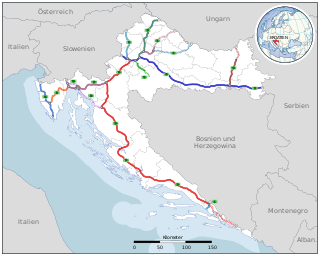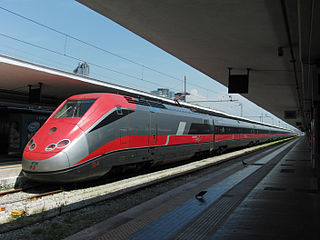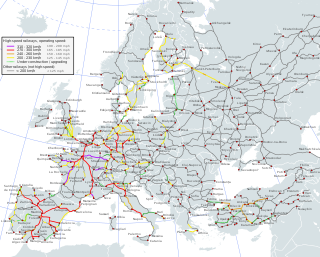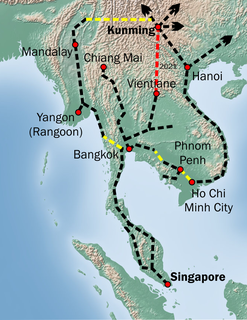
Transport in Croatia relies on several main modes, including transport by car, train, boat and plane. Road transport incorporates a comprehensive network of state, county and local routes augmented by a network of highways for long-distance travelling. Water transport can be divided into sea, based on the ports of Rijeka, Ploče, Split and Zadar, and river transport, based on Sava, Danube and, to a lesser extent, Drava. Croatia has 68 airports, nine of which are international. The country also has several airlines, of which the most notable are Croatia Airlines and Trade Air. Rail transport is fairly developed, with dual track and electrification not very common, although high-speed tilting trains are used on some routes. However, bus still tends to be more common than rail as a mode of inter-city transport.

Transport in Pakistan is extensive and varied, and serves a population of over 212.2 million people. In recent years, new national highways have been built, with the addition of motorways which have improved trade and logistics within the country. Pakistan's rail network owned by Pakistan Railways is also undergoing expansion in recent years. Airports and seaports have been built with the addition of foreign and domestic funding.

The location at the junction of the Mediterranean, the Alps, the Dinarides and the Pannonian Plain and the area being traversed by major rivers have been the reasons for the intersection of the main transport routes in Slovenia. Their course was established already in Antiquity. A particular geographic advantage in recent times has been the location of the intersection of the Pan-European transport corridors V and X in the country. This gives it a special position in the European social, economic and cultural integration and restructuring.

The United Nations Economic Commission for Europe is one of the five regional commissions under the jurisdiction of the United Nations Economic and Social Council. It was established in order to promote economic cooperation and integrations among its member states.

The Trans-European Transport Network (TEN-T) is a planned network of roads, railways, airports and water infrastructure in the European Union. The TEN-T network is part of a wider system of Trans-European Networks (TENs), including a telecommunications network (eTEN) and a proposed energy network. The European Commission adopted the first action plans on trans-European networks in 1990.

The Eurasian Land Bridge, sometimes called the New Silk Road, is the rail transport route for moving freight and passengers overland between Pacific seaports in the Russian Far East and China and seaports in Europe. The route, a transcontinental railroad and rail land bridge, currently comprises the Trans-Siberian Railway, which runs through Russia and is sometimes called the Northern East-West Corridor, and the New Eurasian Land Bridge or Second Eurasian Continental Bridge, running through China and Kazakhstan. As of November 2007, about one percent of the $600 billion in goods shipped from Asia to Europe each year were delivered by inland transport routes.

The ten Pan-European transport corridors were defined at the second Pan-European transport Conference in Crete, March 1994, as routes in Central and Eastern Europe that required major investment over the next ten to fifteen years. Additions were made at the third conference in Helsinki in 1997. Therefore, these corridors are sometimes referred to as the "Crete corridors" or "Helsinki corridors", regardless of their geographical locations.

Attiki Odos is a privately owned toll motorway system in Greece. The Attiki Odos motorways form the outer beltways of the Athens-Piraeus metropolitan area. The total length of the motorways is 65 kilometres (40 mi). The Attiki Odos system consists of the following motorways:

Doncaster railway station is on the East Coast Main Line in England, serving the town of Doncaster, South Yorkshire. It is 155 miles 77 chains (251 km) down the line from London King's Cross and is situated between Retford and York on the main line. It is managed by London North Eastern Railway.

A controlled-access highway is a type of highway that has been designed for high-speed vehicular traffic, with all traffic flow—ingress and egress—regulated. Common English terms are freeway, motorway and expressway. Other similar terms include throughway and parkway. Some of these may be limited-access highways, although this term can also refer to a class of highway with somewhat less isolation from other traffic.

The LGV Sud Europe Atlantique, also known as the LGV Sud-Ouest or LGV L'Océane, is a high-speed railway line between Tours and Bordeaux, in France. It is used by TGV trains operated by SNCF. It is an extension of the LGV Atlantique. The line was inaugurated on 28 February 2017 and with services beginning on 2 July 2017. The line, which was at the time the biggest European railway construction project, was built by the LISEA consortium, which owns and maintains the line until 2061 and charges tolls to train companies. Trains on this line depart Paris from Gare Montparnasse.

European route E 79 is a road part of the International E-road network. It begins in Miskolc, Hungary and ends in Thessaloniki, Greece, also running through Romania and Bulgaria. The road is 1,300 km (810 mi) long.
Kazakhstan Temir Zholy, also National Company Kazakhstan Temir Zholy, is the national railway company of Kazakhstan.
This article lists planned or proposed high-speed rail projects, arranged by country. Although many nations have done preliminary feasibility studies, many lines are eventually shelved or postponed due to high cost, and only a few nations of those proposing are actively building high-speed rail lines. Planned or proposed lines are therefore separated here from lines that are under construction, some nations having both. High-speed rail is public transport by rail at speeds in excess of 200 km/h (125 mph).

High-speed rail in Italy consists of two lines connecting most of the country's major cities. The first line connects Turin to Salerno via Milan, Bologna, Florence, Rome and Naples, the second runs from Turin to Venice via Milan, and is under construction in parts. Trains are operated with a top speed of 300 km/h (190 mph).

High-speed rail (HSR) has developed in Europe as an increasingly popular and efficient means of transport. The first high-speed rail lines on the continent, built in the 1970s, 1980s and 1990s, improved travel times on intra-national corridors. Since then, several countries have built extensive high-speed networks, and there are now several cross-border high-speed rail links. Railway operators frequently run international services, and tracks are continuously being built and upgraded to international standards on the emerging European high-speed rail network.

Transport in the European Union is a shared competence of the Union and its member states. The European Commission includes a Commissioner for Transport, currently Adina Ioana Vălean. Since 2012, the Commission also includes a Directorate-General for Mobility and Transport which develops EU policies in the transport sector and manages funding for Trans-European Networks and technological development and innovation, worth €850 million yearly for the period 2000–2006.
The Trans-European Motorways are a project of the United Nations Economic Commission for Europe of sub-regional cooperation among Central, Eastern and South Eastern European countries regarding transport infrastructure. The Trans-European Railway is the twin project for the railway.

The Kunming–Singapore railway, increasingly called the Pan–Asia railway Network is a network of railways that connects China, Singapore and all the countries of mainland Southeast Asia. The concept originated with British and French imperialists, who sought to link the railways they had built in southwest China, Indochina and Malaya, but international conflicts in the 20th century kept regional railways fragmented. The idea was formally revived in October 2006 when 18 Asian and Eurasian countries signed the Trans-Asian railway Network Agreement, which incorporated the Kunming–Singapore railway into the Trans-Asian railway network.

The Highways in Albania are the central state and main transport network in Albania. The motorways and expressways are both part of the national road network. The motorways are primary roads with a speed limit of 110 kilometres per hour (68 mph). They have white on green road signs such as in Italy and other countries nearby. The expressways are the secondary roads, also dual carriageways, but without an emergency lane. They have a speed limit of 90 kilometres per hour (56 mph). They have white on blue road signs.















